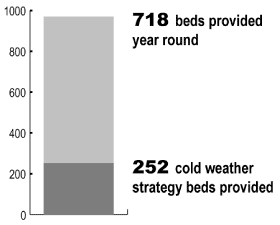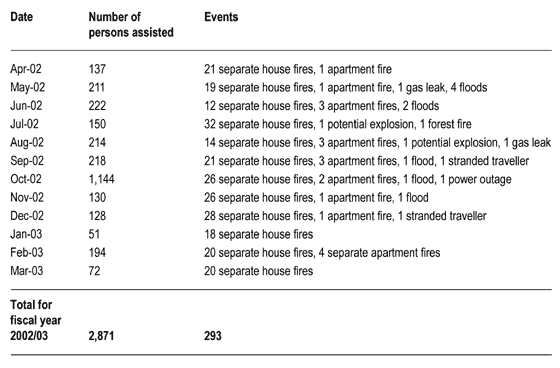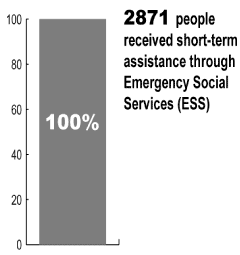Performance Reporting — Continued
Goal 3: BC Employment and Assistance Services Clients' Basic
Health Needs are Met
Objective
Eligible clients have access to supplementary health services
|
Strategy
Provide designated health services to those who are eligible
|
Measure 3.1: Number of persons receiving Enhanced Supplementary
Health Services
Results
| 2002/03 Target |
Results |
| Establish baseline number
of eligible clients receiving supplementary health services |
Baseline established:
73,259
|
Description
This is an output measure that captures the number of people
receiving enhanced supplementary health services. The result represents
the number of eligible clients who received dental or vision services
during the fiscal year. The baseline established in 2002/03 was
73,259 clients receiving supplement health services.
The ministry provided basic health assistance to all BC Employment
and Assistance clients. Basic health assistance includes premium-free
medical services plan (MSP) coverage, 100 per cent Pharmacare
coverage, emergency dental services and dental repairs, and basic
optical coverage. These services were also provided to people
receiving hardship assistance and persons with disabilities who
left income assistance.
Some clients, whose eligibility is established through legislation,
also received enhanced health assistance. This includes premium-free
MSP, 100 per cent Pharmacare coverage and MHR-sponsored health
supplements, such as allowances for special diets, infant formulas,
medical equipment and supplies are examples of the supplements
provided.
This measure is not included in subsequent service plans. The
ministry will, instead, report on the impact of its programs and
services on clients.
Data Reliability and Assumptions
Source: Contractor's database.
Reliability: High.
Other Comments
Supplementary health services are provided by a contractor and
by the ministry. Some services are purchased individually (for
example, dentures or eyeglasses), while others are purchased in
quantity for increased savings (for example, medical supplies
such as bandages, dressings, and catheters). The ministry tracks
both types of services in different ways.
Objective
Homeless individuals have access to safe emergency accommodation
|
Strategy
Provide emergency accommodation to those eligible |
Measure 3.2: Number of beds provided
Results

| 2002/03 Target |
Results |
| Establish baseline number
of beds provided |
Baseline established:
970 beds
(including 718 beds provided year-round and 252 provided
under cold weather strategy)
|
Description
This is an output measure that captures the number of emergency
beds and shelter beds the ministry funds. This measure assesses
the level of support provided through hostels and emergency shelters
throughout B.C. The ministry contracts with operators to provide
safe, temporary accommodation to homeless individuals, couples
and families.
This measure is not included in subsequent service plans because
it measures outputs, rather than outcomes, and the ministry is
striving to increase the number of performance measures that are
outcome-oriented.
Data Reliability and Assumptions
Source: Ministry's contracts with emergency
shelters.
Reliability: High.
Other Comments
It may be more meaningful to assess the number of people using
emergency shelters and hostels, rather than the number of beds
provided. However, the ministry is unable to gather this information
as individuals who visit shelters often do not carry identification
or do not wish to identify themselves to service providers.
Objective
Individuals and families have access to short-term disaster
assistance through the Emergency Social Services (ESS) program
|
Strategy
Provide short-term assistance through the ESS program to those
forced from their homes by disasters |

Measure 3.3: Percentage of individuals and families requiring
short-term assistance who receive services through Emergency Social
Services (ESS)
Results


| 2002/03
Target |
Results |
| 100 per cent of people requiring
short term disaster assistance receive assistance |
100% |
Description
This is an output measure that captures the number of persons
assisted and the number of incidents responded to by Emergency
Social Services (ESS) volunteers and staff. The target for this
measure stated that 100 per cent of those requiring ESS assistance
receive it. This target was achieved in 2002/03.
ESS provides short-term services required to preserve the health
and well-being of people affected by disasters. These include
emergency food, clothing, lodging, family reunification, personal
services and other specialized services as required. In British
Columbia, local authorities are responsible for planning and operating
emergency responses within their jurisdictions. The province assists
local authorities and only takes a lead in the case of a major
disaster. The ESS Branch within the ministry provides broad leadership
and coordination in planning for and responding to emergencies
and disasters where ESS is required.
This measure is not included in subsequent service plans, as
the ministry is striving to increase the number of performance
measures that are outcome-oriented.
Data Reliability and Assumptions
Source: Ministry database.
Reliability: High.
